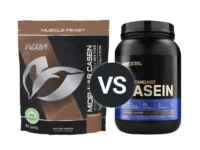Knowledge BaseYou're Questions Answered
BACK
How do Calcium Caseinate and Sodium Caseinate differ?
Calcium Caseinate and Sodium Caseinate are both derived from casein, the protein found in milk, but they differ in terms of their chemical composition, how they're processed, and how they're used in various applications.
Key Differences Between Calcium Caseinate and Sodium Caseinate
- Mineral Composition:
- Calcium Caseinate: This form is produced by adding calcium during the manufacturing process, making it a rich source of calcium. It's often used in nutritional products aimed at promoting bone health due to its calcium content.
- Sodium Caseinate: This version is created by adding sodium instead of calcium. As a result, it has a higher sodium content, which can be a concern for individuals on low-sodium diets.
- Solubility and Stability:
- Calcium Caseinate: Generally, calcium caseinate has lower solubility in water compared to sodium caseinate. It may result in a slightly thicker consistency when mixed with liquids and is often used in products requiring slower digestion, like meal replacement shakes.
- Sodium Caseinate: Sodium caseinate is highly soluble and mixes easily with water, making it ideal for use in liquid products such as beverages, coffee creamers, and some nutritional supplements.
- Digestibility:
- Calcium Caseinate: Like all casein proteins, calcium caseinate is slow-digesting, which means it provides a steady release of amino acids over several hours. This makes it beneficial for sustained protein delivery, particularly overnight or between meals.
- Sodium Caseinate: Sodium caseinate also provides slow-digesting protein, but because of its higher solubility, it can be slightly easier to digest and absorb compared to calcium caseinate.
- Applications:
- Calcium Caseinate: Due to its lower solubility, calcium caseinate is often found in protein powders, meal replacement products, and supplements aimed at providing long-lasting protein, such as bedtime shakes.
- Sodium Caseinate: Its excellent solubility makes sodium caseinate a popular choice in food processing, where it's used as a thickener, emulsifier, and stabilizer in processed foods like coffee creamers, ice creams, and some baked goods.
Similarities
- Both are slow-digesting proteins, ideal for prolonged amino acid release.
- They are derived from casein, the primary protein in milk.
- Both provide all essential amino acids, making them complete protein sources.
- Commonly used in nutritional supplements, protein powders, and food products to enhance protein content.
Calcium Caseinate and Sodium Caseinate differ mainly in their mineral content and solubility. Calcium caseinate offers more calcium and is used in thicker, slower-digesting products, while sodium caseinate is more soluble and used in liquid food applications. Both are excellent sources of slow-digesting protein but serve different roles depending on their form and application.
Was this answer helpful? Let us know!
Like
Add to this Answer
Related Questions

Disclosure
Your Answer
Do you have a suggestion to improve the answer? Please detail your suggestions and provide any references to information that may support your answer if available.
The content on this site has not been written, reviewed or endorsed by a medical professional. We assume no liability for the misuse of supplements and recommend you review the label of any product, as well as consulting with your health care professional.
We are a participant in the Amazon Services LLC Associates Program, an affiliate advertising program designed to provide a means for us to earn fees by linking to Amazon.com and affiliated sites.
We are a participant in the Amazon Services LLC Associates Program, an affiliate advertising program designed to provide a means for us to earn fees by linking to Amazon.com and affiliated sites.
© 2025 ProteinPowder.com






